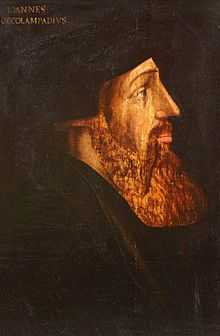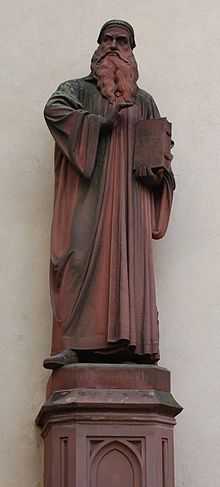Johannes Oecolampadius

Johannes Œcolampadius, or Œkolampad (German: Johannes Oekolampad) (1482 – 24 November 1531) was a German religious reformer from the Electorate of the Palatinate. His real name was Hussgen or Heussgen, a name first changed to Hausschein and then into the Greek equivalent, which is derived from οἶκος oikos, "house," and λαμπάς (gen λαμπάδος) lampas, "lamp".[1]
Life
He was born in Weinsberg, then part of the Electorate of the Palatinate. He attended school at Weinsberg and Heilbronn, and then, intending to study law, he went to Bologna, but soon returned to Heidelberg and took up theology. Enthusiastic about the new learning, he passed from the study of Greek to that of Hebrew, taking his bachelor's degree in 1503. He became cathedral preacher at Basel in 1515, serving under Christoph von Utenheim, the humanist bishop of Basel. In Basel, Oecolampadius became an editorial assistant and Hebrew consultant to Erasmus' first edition of the Greek New Testament, and wrote that edition's epilogue in praise of his master.[2]
Career
From the beginning the sermons of Oecolampadius centred on the atonement, and his first reformatory zeal showed itself in a protest (De risu paschali, 1518) against the introduction of humorous stories into Easter sermons. In 1520 he published his Greek Grammar. The same year he received an invitation to become preacher in the high church in Augsburg. Germany was ablaze with the questions raised by Martin Luther's theses, and Oecolampadius's introduction into this environment, when he championed Luther's position, especially in his anonymous Canonici indocti (1519), seems to have compelled him to severe self-examination, which ended in his becoming a monk. A short experience convinced him that this was not for him the ideal Christian life ("amisi monachum, inveni Christianum" — "I have lost the monk; I have found the Christian"), and in February 1522 he made his way to Ebernburg, near Creuznach, where he acted as chaplain to a little group of men holding the new opinions who had settled there under the leadership of Franz von Sickingen.

Oecolampadius returned to Basel in November 1522, as vicar of St Martin's, and (in 1523) reader of the Holy Scripture at the University of Basel. Lecturing on Isaiah, he condemned current ecclesiastical abuses, and in a public disputation (August 20, 1523) gained such success that Erasmus writing to Zürich said, "Oecolampadius has the upper hand amongst us." He became Huldrych Zwingli's assistant, and after more than a year of earnest preaching and four public disputations in which the popular verdict went in favour of Oecolampadius and his friends, the authorities of Basel began to see the need for Reformation.
At last Oecolampadius was able to refrain from some practices he believed to be superstitious. Basel was slow to accept the Reformation; the news of the Peasants' War and the inroads of Anabaptists prevented progress; but by 1525, it seemed as if the authorities were resolved to listen to schemes for restoring the purity of worship and teaching. In the midst of these hopes and difficulties Oecolampadius married, in the beginning of 1528, Wibrandis Rosenblatt, the widow of Ludwig Keller, who proved a suitable wife. After his death she married Wolfgang Fabricius Capito, and, when Capito died, Martin Bucer. She died in 1564.
In January 1528 Oecolampadius and Zwingli took part in the disputation at Bern which led to the adoption of the new faith in that canton, and in the following year to the discontinuance of the Mass at Basel. In 1529 he became officially the Antistes of the Reformed Church in Basel. The Anabaptists claimed Oecolampadius for their views, but in a disputation with them he dissociated himself from most of their positions. He died on 24 November 1531.
Theology

Oecolampadius was considered to be a brilliant Protestant theologian, who conversed with Johannes Eck, Philipp Melanchthon and was Professor of theology at the University of Basel.[3] As a theologian, he did not have the clamour of Luther, Zwingli or John Calvin, but he became a trusted religious leader. He was respected even among Catholic scholars of his time and was quoted over forty years after his death by the Jesuit St. Peter Canisius in his work De Maria Virgine. [4] With Zwingli he represented the Swiss at the Marburg Colloquy. His views on the Eucharist upheld the metaphorical against the literal interpretation of the word "body," but he asserted that believers partook of the sacrament more for the sake of others than for their own, though later he emphasized it as a means of grace for the Christian life. To Luther's doctrine of the ubiquity of Christ's body he opposed that of the presence and activity of the Holy Spirit in the church. His views on the Eucharist prompted Luther to publish several sermons on the subject in his 1526 The Sacrament of the Body and Blood of Christ—Against the Fanatics. He did not minutely analyse the doctrine of predestination as Luther, Calvin and Zwingli did, contenting himself with the summary "Our Salvation is of God, our perdition of ourselves." Calvin held his work in high regard, and through his writings and his influence in Basel (where Calvin wrote his first edition of the Institutes), Oecolampadius served as an intermediary between the humanism of Erasmus and the hermeneutics of Calvin.[5]
Theologically he was considered to be close to Zwingli, with whom he shared a friendly attitude towards Mary and Marian veneration. He is considered an example of Protestant Marian piety of his time, largely in light of his sermons. He calls Mary the mediatrix or mediator (Mittlerin) of all graces, to whom the Lord had entrusted the treasure of Grace Thesaurus gratiarum. [4] Oecolampadius borrowed from Radulfus Ardens (d. 1200) and others the image of Mary as the neck who mediates all graces of Christ (the Head) to his mystical body, the church. This view was defended in the 20th century by Gabriel Roschini, and more generally, by Pope Pius XII in his encyclical Mystici Corporis as official doctrine of the Catholic Church.[4]
In De laudando in Maria Deo given in Augsburg 1521, he states, that God cannot be praised more in any creature than through Mary. His gifts and graces are expressed in her. God honoured her by becoming human through her. Mary surpassed Abraham with her faith, Isaac with her patience and Joseph with her chastity. She is queen of all heavenly powers.[4] Yet, according to Oecolampadius, Catholic veneration of Mary went too far, because of the numerous titles given to Mary: they surpass in number and content the veneration of Christ himself. The rosary is cited as an example with its 150 Hail Marys and only ten prayers to God. He is also critical of popular customs, by which every Saturday is solemnly observed in her honour, with abstinence from wine and sexual relations, while the following Lord’s day is characterized by heavy drinking and all kinds of entertainments. Throughout his life, Oecolampadius preached the perpetual virginity of Mary, who through her life and her works gave a shining example of Christian virtues. Mary’s life was a life of service and compassion as documented in her visit to Elizabeth.[4]
References
- ↑ οἶκος, λαμπάς. Liddell, Henry George; Scott, Robert; A Greek–English Lexicon at the Perseus Project.
- ↑ J. Brashler, "From Erasmus to Calvin: Exploring the Roots of Reformed Hermeneutics", Interpretation 63(2) April 2009, p. 163.
- ↑ Bäumer, p. 672
- ↑ 4.0 4.1 4.2 4.3 4.4 Bäumer, p. 673
- ↑ Brashler, ibid. pp. 164-166
References
- “Johannes Oekolampadius” in Remigius Bäumer, Leo Scheffczyk (editors) Marienlexikon Gesamtausgabe, Institutum Marianum Regensburg, 1994, ISBN 3-88096-891-8 (cit. Bäumer)
 This article incorporates text from a publication now in the public domain: Chisholm, Hugh, ed. (1911). "Oecolampadius, John". Encyclopædia Britannica (11th ed.). Cambridge University Press This work in turn cites:
This article incorporates text from a publication now in the public domain: Chisholm, Hugh, ed. (1911). "Oecolampadius, John". Encyclopædia Britannica (11th ed.). Cambridge University Press This work in turn cites:
- J. J. Herzog, Leben Joh. Oecolampads und die Reformation der Kirche in Basel (1843)
- K. R. Hagenbach, Johann Oecolampad und Oswald Myconius, die Reformatoren Basels (1859)
- W. Hadorn's article in Herzog-Hauck's Realencyklopädie für prot. Rel. u. Kirche.
Further reading
- Poythress, Diane. Reformer of Basel: The Life, Thought, and Influence of Johannes Oecolampadius. Reformation Heritage Books, 2011.
External links
| Wikimedia Commons has media related to Johannes Oecolampadius. |
 Friedrich Lauchert (1913). "John Œcolampadius". Catholic Encyclopedia. New York: Robert Appleton Company.
Friedrich Lauchert (1913). "John Œcolampadius". Catholic Encyclopedia. New York: Robert Appleton Company.
| Religious titles | ||
|---|---|---|
| New title | Antistes of Basel 1530–1531 |
Succeeded by Oswald Myconius |
|